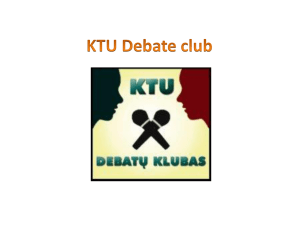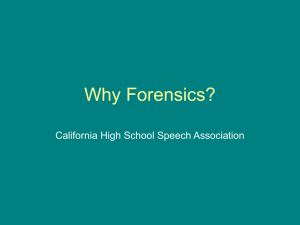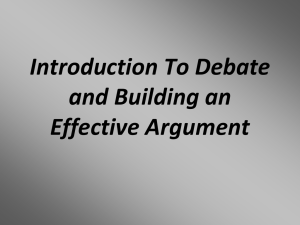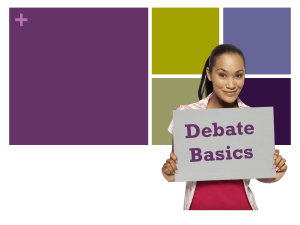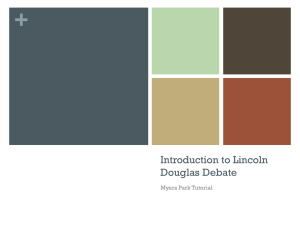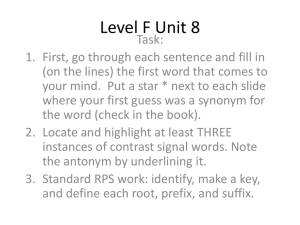Oratorical and Debate Topic/Criteria/Rules
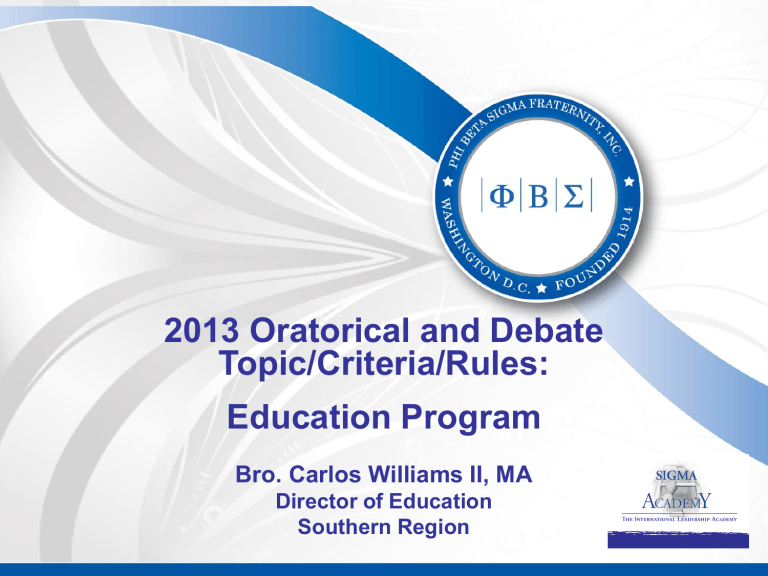
2013 Oratorical and Debate
Topic/Criteria/Rules:
Education Program
Bro. Carlos Williams II, MA
Director of Education
Southern Region
Southern Region and State Oratorical
Contests
Participants must adhere to the following contest rules:
• Each participant will have seven minutes to address the given topic
• No props are allowed
• Each participant must present a perspective supported with relevant reasons and/or examples
• Participants must demonstrate a knowledge of current issues to validate perspectives
• Participants must be able to organize thoughts in a cohesive and fluid manner
Phi Beta Sigma Fraternity, Inc. 2013
Oratorical Topic
Oratorical Format: 7 Minute Speech in the affirmative OR negative.
Below are the Oratorical Topic for 2012-2013.
Oratorical Topic:
1.) The three International Programs of Phi Beta Sigma Fraternity, Inc. (Education; Bigger and
Better Business; and Social Action) are the life blood of the fraternity. The partnerships we establish with outside organizations, strengthens our International effort and the programs, and helps us reach the overarching goals of the fraternity. Please identify the potential impact these partnerships have on Phi Beta Sigma ’ s Programs, and how we can best utilize them to our advantage.
Oratorical Contest Judging Criteria
ATTIRE:
Shirt, tie and/or business suit
TIME:
3 minutes minimum - 7 minutes maximum
Criteria for participants:
1. Appropriate business attire
2. Authenticity of content
3. Inclusion of topic
4. Maintaining eye contact with audience
5. Participants cannot use technology, props and other tools. If the speech is not memorized, the use of notes is permissible.
Criteria for judging:
1. Articulation {20 pts.}
2. Stage Presence, Interaction with audience {20 pts.}
3. Creativity {20 pts.}
4. Theme: personal, local or national news/sources interwoven into speech {20 pts}
5. Content: Research, focus, organization, coherent thoughts {20 pts.}
Oratorical Contest Judging Criteria
Criteria for Evaluating Persuasive Speakers
NOTE: Judges evaluate each performer individually based on the total presentation. At the end of the round, performers are ranked in order of the quality of the presentations: Best is first, second best is second, and so on. All contestants are ranked. There can be no ties.
The following criteria are of equal importance in evaluating the speaker:
•
•
•
•
I. Analysis and Content
• Did the speaker answer the question?
Was the content persuasive?
Was there sufficient use of logic, facts, examples, and/or expert opinion?
Was the information adequately documented?
Was the information pertinent to the specific topic?
•
•
II. Organization
• Introduction
–
Did the speaker get attention?
– Was the topic clearly stated?
– Did the speaker preview and give focus to the key ideas?
Body
–
Were divisions clear and appropriate to the topic?
– Did the speaker make effective use of signposting, internal summaries, and transitions?
– Was adequate time devoted to each division within the 7 minute time limit?
– Was there a logical progression of ideas?
Conclusion
–
Did the speaker tie the speech together?
– Was the answer to the question clear?
– Was there a note of finality?
Oratorical Contest Judging Criteria
•
•
•
•
III. Delivery
• Was the delivery natural, lively, and spontaneous?
Did it reinforce the ideas of the speech?
Language Style
–
Did the speaker exhibit command of conversational style?
– Was the language suitable to persuading the audience?
– Was the language precise, grammatically correct, and vivid?
Vocal Delivery
–
Was enunciation clear?
– Was volume appropriate?
– Was there sufficient variety in rate, pause, and pitch?
Physical Delivery
–
Did the speaker exhibit poise and confidence?
– Were gestures varied, movement motivated, and eye contact direct?
– If note card was used, was it an integrated part of the delivery?
Judges are encouraged to write comments and are given the following instructions: "The best critiques teach and encourage the student. Please offer reasons for your evaluation in the comments you write below.
“
Source: University Interscholastic League ( http://www.uiltexas.org/speech/debate/criteria-for-judging-cx-debate
Debate Contest Topic & Format
Phi Beta Sigma Fraternity will use Cross
Examination Debate (CX Debate) as the style for the debate.
Each state will sponsor a two-member team to compete in the Regional Debate Contest.
Debate Contest Topic & Format
Step 1: Refer to the following website for information on understanding Cross Examination Debate http://debatecentral.ncpa.org/understand-cross-examination-debate/
Step 2: You will see a number of articles speaking on Cross
Examination Debate.
Step 3: Review the Research Topic Link for a variety of resources which can be implemented in your debate. Especially take note of the Glossary Terms which will strengthen your vocabulary of selected topic.
Step 4: Each team MUST prove the affirmative AND the negative of the topic for debate. Using facts, statistics, news, etc. for evidence.
Debate Contest Topic & Format
Step 4: Please scroll to the Outline of CX Debate included in this deck and review the debate outline structure. The debate will encompass 20 minutes. Teams must prepare for both the affirmative and negative.
Step 5: Once you have reviewed the debate format return to the
Understand Cross Examination Debate Page and review EACH file related to CX Debate. This should be extremely supportive in understanding the intricacies of debating.
Step 6: Your team preparation for the debates should include use of any scholarly resources on the world wide web; however, you may use others as well.
Phi Beta Sigma Fraternity, Inc. 2012
Debate Topic
• Debate Contest Topic:
Debate Topic (Argue in the Affirmative and Negative):
1.) Education is the primary objective for attending universities.
Many faculty and administrators at major colleges and universities have put forth the notion of the elimination of all fraternities and sororities, to increase focus and academic performance. Please share with us how these organizations are, or are not, still needed on major college and university campuses.
• 20 minutes
Criteria for Judging CX Debate
Source: University Interscholastic League ( http://www.uiltexas.org/speech/debate/criteria-for-judging-cx-debate )
1. Debate is a contest in arguing a specific resolution. Each affirmative team will interpret the resolution differently. Your task is to determine whether the affirmative proves that the adoption of the resolution would be in the best interests of the United States.
2. Regardless of your judging philosophy, there are generally six types of arguments which may evolve in a debate round. To make your judgment, you should take notes, and after the round, balance the issues. This will help you determine, based on what the debaters presented , whether adopting the resolution is in the best interests of the United States.
Issues
Affirmative
Topicality
Definition
Harms
Significance
Inherency
Solvency
Whether the affirmative plan supported by the case is within the current resolution.
Who or what is being hurt.
Whether the harm the affirmative talks about is really important.
Whether the problem the affirmative talks about can be solved by the present system without much modification.
Whether the affirmative plan can meet the needs described in the affirmative case.
A common negative issue
Disadvantages Whether the affirmative plan would create additional problems beyond meeting the affirmative needs.
Criteria for Judging CX Debate
Source: University Interscholastic League ( http://www.uiltexas.org/speech/debate/criteria-for-judging-cx-debate )
3 .
Making the decision:
1.
Is the case topical? Unless the negative disproves this, assume it is. If not, vote negative. DON'T
USE YOUR OWN BIAS.
2.
Inherency/Solvency Balancing. Balance how much of the problem can be solved by the affirmative proposal. If part of the problem remains, go on.
3.
Significance/Disadvantages Balancing. Balance the gains expected with the affirmative system over the present system with any disadvantages the negative has proven will occur in the new system. If the advantages outweigh the disadvantages, vote affirmative. If not, vote negative.
4.
Speed of delivery: Some debaters have developed an excessively rapid style of delivery that interferes with the element of communication that is basic to debate. The ballot provides an avenue for indicating to the debater that speed of delivery did or did not interfere with communication. The speaker whose speed of delivery is considered excessive should be given a 2 or 3 in speaker points. The speaker whose delivery is not considered excessively rapid should be given a 4 or 5 in speaker points. If the speaker's speed of delivery interferes with your ability to follow the course of the debate, you should also lower the speaker points in those categories where the debater failed to communicate.
5.
Filling out the ballot:
1.
Record decision (affirmative or negative)
2.
Award points (30 points is highest) to each debater. Since speaker points are a crucial determinant of advancement, avoid excessively low speaker points unless truly warranted.
3.
Award ranks (1,2,3,4 with 1st being awarded to the debater with the most points and so on) to debaters. Points and ranks should correspond.
4.
Write your reasons for your decision in the space provided.
5.
Sign your ballot.
Criteria for Judging CX Debate
Source: University Interscholastic League ( http://www.uiltexas.org/speech/debate/criteria-for-judging-cx-debate )
6 .
Preparation Time. A team shall take no more than eight minutes total elapsed preparation time during a round of debate.
Presenting a very brief preview of argument order before speeches, often referred to as a “ roadmap, ” aids in clarity of the round and is not considered part of the speech. However, debaters should not abuse this privilege by excessive length of the roadmap. Abuse may count against a team at the discretion of the judge(s).
Debate 101
A debate is a formal way of testing an idea or proposition. In debate, the idea is called the resolution. In policy debate, the resolution takes the form: Resolved: That an entity should take an action .
1.
2.
3.
One side, called the affirmative, has the duty to affirm or support the resolution. The affirmative side presents a case that proposes a plan and reasons for adopting the plan. In the affirmative speeches, debaters typically show a need for the plan, describe the plan, and demonstrate the advantages of the plan. Debaters often craft their speeches with an eye toward judging criteria, of which there are many. One judging system uses what are called stock issues. The stock issues are:
4.
5.
Topicality – Does the case reasonably adhere to the topic as delimited by the resolution?
Significance – Is there a significant problem that justifies changing the present system?
Inherency – Is there an inherent barrier in the current system that keeps it from solving the problem indicated in the affirmative case? Alternatively stated, is the current system inherently flawed or does it just need repair?
Solvency – Would the proposed plan solve the problem better than the present system?
Advantages – Do the advantages of the proposal outweigh the disadvantages of the proposal?
To win in this judging system, the affirmative case must receive a yes answer to every one of those questions. The negative side wins if the judge answers any question with no . There are other judging systems, but the stock issues provide a good structure for conceptualizing the affirmative case.
The other side, called the negative, because its job is to negate the plan offered by the affirmative side, presents a case that either upholds the status quo, i.e. shows that the affirmative side ’ s plan should not be supported, or that another plan is superior to the one proposed by the affirmative side. Note that the negative side does not have to negate the resolution. It simply has to negate the plan offered by the affirmative side. An illustration will clarify.
Let ’ s say that the affirmative side proposes a plan that the federal government should improve mental health by ending compulsory education because doing so would make kids happy, and being happy is essential to good mental health. The negative side could easily show the weaknesses in that plan without rejecting the resolution itself.
Because the affirmative side has the responsibility of supporting the resolution, the affirmative side goes first and last.
Debate 101 (cont.)
Speaker A has the following responsibilities: introduce the resolution, describe the problem, define terms in the resolution, demonstrate a need for a plan, and present the plan.
Speaker B has the responsibility of negating the plan proposed by Speaker A. There are many ways to do this. Some common techniques used by the negative speaker include: proposing another definition of the problem, offering alternative definitions of terms, denying the need for the plan, pointing out the inability of the plan to meet the need, denying the need for any plan by defending the status quo, and offering a counterplan. Speaker B may also ask for clarification and specification of the plan.
In the second affirmative speech, Speaker A has two major tasks: review the cases presented by each side while pointing out the major areas of conflict (called clash in debate jargon), and respond to the attacks made by Speaker B. Additionally, speaker A must demonstrate that the plan proposed in the first speech will solve the problem and that the plan will do so without causing more problems than it solves.
In the second negative speech, Speaker B reviews the areas of conflict and restates the negative position. Speaker B goes on to attack the plan. There are many strategies. Common strategies include denying that the plan solves the problem, denying that the plan is workable, or asserting that the plan would cause more problems than it would solve.
In the third affirmative speech, Speaker A responds to the negative rebuttal, summarizes the issues, and makes a final defense of the plan.
Cross examination provides an opportunity to clarify any points just raised, however the skillful debater also uses cross examination to advance his or her side of the debate. This is accomplished by asking questions for which the other side has no adequate answer, that reveal weaknesses in the affirmative case, or the answers to which can later be used by the cross examiner to bolster his or her side of the argument. The questioner should be cautious in asking questions, however, because the answers may serve to bolster the opponents
’ case. Generally, a questioner should ask a question only if he anticipates that the answer will support his side of the debate.
Rebuttal speeches provide the opportunity to defend the position each side has laid out. No new arguments may be introduced in rebuttal speeches.
Debate 101 (cont.)
As mentioned previously, there are many criteria by which one may judge a debate. In addition to the stock issues system mentioned above, another is the policy maker system. This system is built on the idea that judges should decide debates much as legislators would, i.e. the affirmative side wins if the plan is topical and its advantages outweigh the disadvantages presented by the negative. Another system awards the win to the side that scores the most points according to a predetermined list of criteria.
In addition to the many systems judges may use to select a winner, there are theories that influence judging. One theory holds that the judge should be a blank slate (tabula rasa) and should judge only according to what each side says in the debate. Another theory holds that the judge is a critic, that he or she critically evaluates the quality of the arguments each side makes, and makes a decision based on the quality of those arguments. It becomes apparent that judging the winner of a debate can be a challenge.
For the purposes of this class, we will not be selecting a winner, however students are well advised to consider the quality of their arguments.
Sources:
Eisenberg, A.M, & Ilardo, J.A. (1980). Argument: A guide to formal and informal debate (2 nd ed.). Englewood Cliffs, NJ: Prentice-Hall.
Freeley, A.J. (1966). Argumentation and debate: Rational decision making (2 nd ed.). Belmont, CA: Wadsworth.
Kruger, A.N. (1960). Modern debate: Its logic and strategy . New York: McGraw-Hill.
Musgrave, G.M. (1957). Competitive debate: Rules and procedures (3 rd ed.). New York: Wilson.
Thomas, D.A., & Hart, J. (1987). Advanced debate: Readings in theory practice and teaching (2 nd
Textbook.
ed.). Lincolnwood, IL: National
Comments, Questions & Concerns
Bro. Carlos Williams II, MA wickedblue@aol.com
404.435.3681 (cell)

